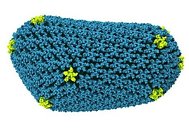- Joined
- Oct 9, 2007
- Messages
- 47,511 (7.48/day)
- Location
- Hyderabad, India
| System Name | RBMK-1000 |
|---|---|
| Processor | AMD Ryzen 7 5700G |
| Motherboard | ASUS ROG Strix B450-E Gaming |
| Cooling | DeepCool Gammax L240 V2 |
| Memory | 2x 8GB G.Skill Sniper X |
| Video Card(s) | Palit GeForce RTX 2080 SUPER GameRock |
| Storage | Western Digital Black NVMe 512GB |
| Display(s) | BenQ 1440p 60 Hz 27-inch |
| Case | Corsair Carbide 100R |
| Audio Device(s) | ASUS SupremeFX S1220A |
| Power Supply | Cooler Master MWE Gold 650W |
| Mouse | ASUS ROG Strix Impact |
| Keyboard | Gamdias Hermes E2 |
| Software | Windows 11 Pro |
Researchers at the University of Illinois at Urbana-Champaign (UIUC) have achieved a major breakthrough in the battle to fight the spread of the human immunodeficiency virus (HIV) using NVIDIA Tesla GPU accelerators, NVIDIA today announced.
Featured on the cover of the latest issue of Nature, the world's most-cited interdisciplinary science journal, a new paper details how UIUC researchers collaborating with researchers at the University of Pittsburgh School of Medicine have, for the first time, determined the precise chemical structure of the HIV "capsid," a protein shell that protects the virus's genetic material and is a key to its virulence. Understanding this structure may hold the key to the development of new and more effective antiretroviral drugs to combat a virus that has killed an estimated 25 million people and infected 34 million more.



UIUC researchers uncovered detail about the capsid structure by running the first all-atom simulation of HIV on the Blue Waters Supercomputer. Powered by 3,000 NVIDIA Tesla K20X GPU accelerators -- the highest performance, most efficient accelerators ever built -- the Cray XK7 supercomputer gave researchers the computational performance to run the largest simulation ever published, involving 64 million atoms.
"It would have been very difficult to run a simulation of this size without the power of GPU-accelerated supercomputing in the Blue Waters system," said Klaus Schulten, professor of physics at the University of Illinois. "We started using GPU accelerators more than five years ago, and GPUs have fundamentally accelerated the pace of our research."
Designed to accelerate a broad range of scientific and technical computing applications, NVIDIA Tesla GPU accelerators are enabling researchers worldwide to make dramatic new breakthroughs across a variety of scientific domains -- including alternative energy, astrophysics, drug development, and climate research, among others. They deliver significantly higher performance and better energy efficiency as compared with CPU-based systems.
"GPUs help researchers push the envelope of scientific discovery, enabling them to solve bigger problems and gain insight into larger and more complex systems," said Sumit Gupta, general manager of the Tesla Accelerated Computing Business Unit at NVIDIA. "Blue Waters and the Titan supercomputer, the world's No. 1 open science supercomputer at Oak Ridge National Labs, are just two of many GPU-equipped systems that are enabling the next wave of real-world scientific discovery."
Capsid May Be Key to More Effective Drugs
With the planned addition of more GPUs to the Blue Waters system, UIUC researchers expect to increase simulation times, providing additional insight into the structure and behavior of the HIV capsid.
The capsid has become an attractive target for the development of new antiretroviral drugs, largely due to the discovery that Rhesus monkeys have developed an immunity to HIV through a protein that disrupts capsid functioning.
The capsid is the protein cell of a virus, containing the virus's genetic material. It protects and "smuggles" the genetic material into the human host cell. Once inside, it uncoats the material and initiates the infection.
No existing HIV drug treatments are designed to target the capsid. However, by providing a better understanding of the structure of the HIV capsid, pharmacologists have a wealth of new information to develop new and potentially more effective antiviral HIV drugs.
View at TechPowerUp Main Site
Featured on the cover of the latest issue of Nature, the world's most-cited interdisciplinary science journal, a new paper details how UIUC researchers collaborating with researchers at the University of Pittsburgh School of Medicine have, for the first time, determined the precise chemical structure of the HIV "capsid," a protein shell that protects the virus's genetic material and is a key to its virulence. Understanding this structure may hold the key to the development of new and more effective antiretroviral drugs to combat a virus that has killed an estimated 25 million people and infected 34 million more.



UIUC researchers uncovered detail about the capsid structure by running the first all-atom simulation of HIV on the Blue Waters Supercomputer. Powered by 3,000 NVIDIA Tesla K20X GPU accelerators -- the highest performance, most efficient accelerators ever built -- the Cray XK7 supercomputer gave researchers the computational performance to run the largest simulation ever published, involving 64 million atoms.
"It would have been very difficult to run a simulation of this size without the power of GPU-accelerated supercomputing in the Blue Waters system," said Klaus Schulten, professor of physics at the University of Illinois. "We started using GPU accelerators more than five years ago, and GPUs have fundamentally accelerated the pace of our research."
Designed to accelerate a broad range of scientific and technical computing applications, NVIDIA Tesla GPU accelerators are enabling researchers worldwide to make dramatic new breakthroughs across a variety of scientific domains -- including alternative energy, astrophysics, drug development, and climate research, among others. They deliver significantly higher performance and better energy efficiency as compared with CPU-based systems.
"GPUs help researchers push the envelope of scientific discovery, enabling them to solve bigger problems and gain insight into larger and more complex systems," said Sumit Gupta, general manager of the Tesla Accelerated Computing Business Unit at NVIDIA. "Blue Waters and the Titan supercomputer, the world's No. 1 open science supercomputer at Oak Ridge National Labs, are just two of many GPU-equipped systems that are enabling the next wave of real-world scientific discovery."
Capsid May Be Key to More Effective Drugs
With the planned addition of more GPUs to the Blue Waters system, UIUC researchers expect to increase simulation times, providing additional insight into the structure and behavior of the HIV capsid.
The capsid has become an attractive target for the development of new antiretroviral drugs, largely due to the discovery that Rhesus monkeys have developed an immunity to HIV through a protein that disrupts capsid functioning.
The capsid is the protein cell of a virus, containing the virus's genetic material. It protects and "smuggles" the genetic material into the human host cell. Once inside, it uncoats the material and initiates the infection.
No existing HIV drug treatments are designed to target the capsid. However, by providing a better understanding of the structure of the HIV capsid, pharmacologists have a wealth of new information to develop new and potentially more effective antiviral HIV drugs.
View at TechPowerUp Main Site








